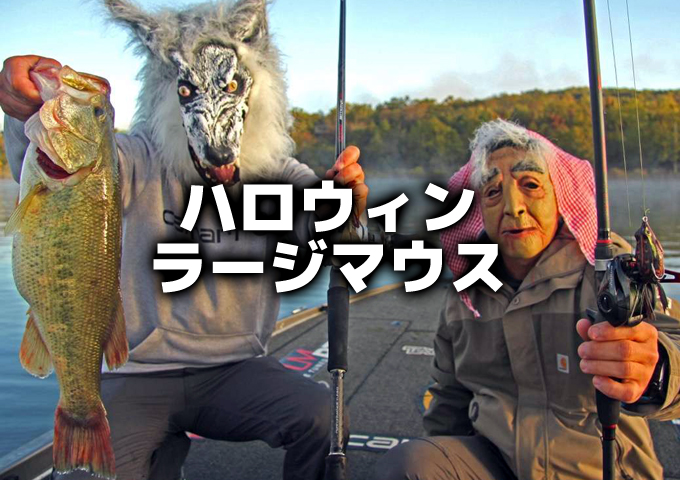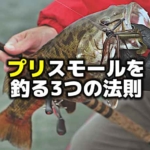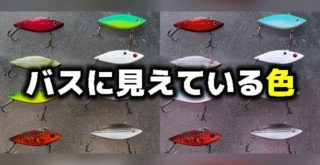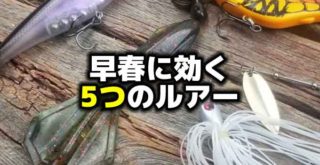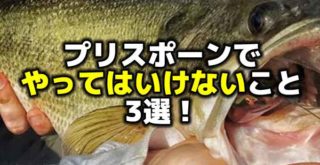スモールマウスバスをジグで釣る

Photo by in-fisherman.com
こんにちは!店長の小山です!
本日は海外サイトより、”Solutions for Smallmouth Bass Jigs”という記事を引用してご紹介いたします。
引用先:in-fisherman.com”Solutions for Smallmouth Bass Jigs”by Matt Straw February 24th, 2016(海外サイトです)
※この記事は当ブログ2016年6月30日の記事を再編集しております。
スモールマウスバスをジグで釣るということ。
ジグというのは幅があります。一般的にジグと言えばジグヘッドリグのことを指すでしょうか、ジグヘッドリグはスモールマウスにとても有効なリグで、1年中使われていると言っても過言ではありません。
他にはフットボールジグ、スモラバなどももちろんジグに含まれますし、いずれもスモールマウスに実績があるものですね。
こうして見ると、スモールマウスバスとジグは切っても切れない関係にあることが分かります。
しかしご存知の通り、そのジグの幅をさらに広げるものに「ウエイト」や「ヘッド形状」というものがあり、さらに「フックサイズ」なども重要になってきます。さらにさらに、そこに組み合わせるワームの種類まで考えるとその選択肢は無限に広がってしまい、ただ単に「ジグで釣れるよ」と教えてもらっても、ありがたいのですがそれだけでは何の役にも立ちません…。
この記事は、アメリカのフィッシング専門メディア「In-Fisherman」の記事で、アウトドア作家であり熱心な釣り人であるマット・ストロー氏がジグヘッドの種類や使い方などを具体的な製品ごとにいくつか紹介してくれています。
ジグのことをもっと深く知れば、スモールマウスにもっと近づけるのでしょうか。ぜひ読んでみましょう。
ベストなスイミングのために
In every jigging situation, we’re looking for a jig that’s best for that presentation. Jigs can be designed to fall fast or slowly, swim horizontally, spiral on the drop, glide, shed cover, carry specific types of plastic, dart to the side—any number of things. Each situation calls for a specific technique, and each technique suggests fairly specific tools. The more specific we can make tools in meeting demands in each situation, the better off we are.
For the past few years I’ve been exploring the realm between ultralight and light tackle. Some may remember the Dr. Jekyl—Mr. Hyde analogy from past articles. Today’s unbelievably light-yet-powerful 3- to 5-pound braided lines are like an elixir, transforming light-power Dr. Jekyl rods into maniacal Mr. Hyde whuppin’ sticks. Tie in three feet of 6- to 8-pound fluorocarbon leader on your jig combo. It’s capable of casting 5-inch grubs, worms, other plastics, and light hair jigs farther than you’ve thrown them before, with the right reel.
Many jigs match this system, depending on conditions. Say you’re swimming 4-inch finesse worms horizontally, off bottom over rock fields and along the edges of shallow reefs. With 4-pound braid and a 1/16-ounce jig in water less than 6 feet deep, the package sinks too fast to swim at effective speeds. Despite braid’s lack of stretch, 4-pound will not drive home a stout hook when combined with a whippy rod.
Stout hooks are heavy. Most manufacturers weigh the head, not the whole package. For lightweight operations, the Gopher Tackle Mushroom Head Jig with Gamakatsu 1/0 and 2/0 hooks excel. Gopher offers options in hook style and size with each head. They vary in weight, gap, sharpness, and bendability.
The flat back of the Gopher and other mushroom-shape jigs creates a seamless profile between the head and the softbait for a natural appearance in shallow water, where visibility is best. The right shape, hook, and weight make this head ideal for swimming softbaits on spinning tackle with braid and a fluoro leader. But the vast “swim jig” category encompasses almost every style of jig and every kind of tackle. Go online to Tackle Warehouse and search for “bass swim jig.” Sixty models pop up. Most have skirts and weedguards.
ジグを使うあらゆる状況において、私たちはそのプレゼンテーションに最適なジグを探しています。ジグは、速くまたはゆっくりとフォールしたり、水平に泳いだり、スパイラルフォールしたり、滑ったり、カバーをかわし、特定のワームを付けられ、横っ飛びするなどというふうに設計されています。それぞれの状況ではそれぞれのテクニックがあり、それぞれのテクニックにはそれ用のツールがあります。具体的には、それぞれの状況で必要となるツールを使うことができれば、より良い結果が得られます。
過去数年間、私はウルトラライトからライトタックルに取り組んでいます。ジキル博士とハイド氏の話に例えれば、信じられないほど軽くて強力な3-5ポンドのPEラインによって、ライトアクションのジキル博士の万能ロッドを狂ったハイド氏が強いロッドに変えてしまったような感じです。あなたのジグに6から8ポンドのフロロリーダーの1メートルほど結びます。これは、正しいリールと組み合わせることで、あなたがこれまで投げていた5インチグラブ、その他のワーム、軽いヘアジグをさらに遠くにキャストすることができます。
条件によっては、多くのジグがこのシステムに適合します。 4インチのフィネスワームを岩場のボトムを切って、シャローの岩盤までエッジに沿って水平に泳がせたいとします。 深さ1.8メートル未満の水深で4ポンドのPEに1/16オンスのジグを使おうとすると、沈みが速すぎて効果的な速度で泳ぐことができません。PEラインには伸びがないにもかかわらず、4ポンドではしなやかなロッドと組み合わせたとき太軸のフックを貫通させることができません。
太軸フックは重いです。ほとんどのメーカーは、フック全体ではなく、ヘッドの重量を測って表示しています。軽量なジグとして、がまかつ1/0と2/0フックを持つ「Gopher Tackle Mushroom Head Jig」は優れています。ゴーファーは、各ヘッドのフックスタイルとサイズのオプションを提供しています。ウエイト、ゲイプ、鋭さ、および柔軟性が異なります。
ゴーファーや他のマッシュルームヘッドジグの平らな背面は、ヘッドとワームの間に自然なシルエットを作り、視界がよいシャローエリアでの自然な見た目を作り出します。適切なヘッド形状、フック、ウエイトは、PEとフロロリーダーを巻いたスピニングタックルでのスイミングに最適です。しかし、広大な “スイミングジグ"のカテゴリには、ほぼすべてのスタイルのジグやあらゆる種類のタックルが含まれています。タックルウェアハウス(Tackle Warehouse)にオンラインでアクセスし、「bass swim jig」と検索してみてください。60種類ものモデルがヒットします。ほとんどがスカートとウィードガードを持っています。
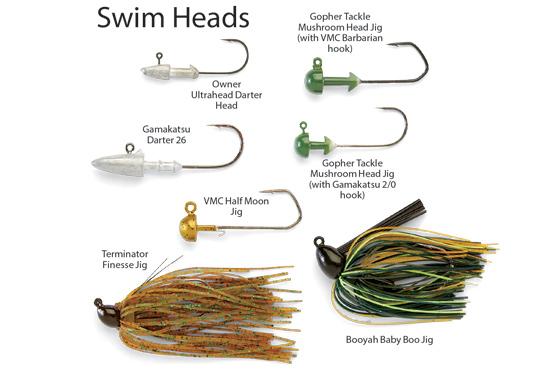
Photo by in-fisherman.com
In-Fisherman contributor Rich Zaleski told me a couple years ago he used Lunker City Football Heads to swim plastics for smallmouths. “I’m still a big fan of light football heads with wire weedguards for grub fishing,” he told me. “I fish grubs slowly, and often let them rest on bottom. The football head lies flat, making it more snag-resistant than a ballhead. I usually fish 1/16- to 1/4-ounce versions with a twin wire guard if there’s wood or rock cover to deal with.”
Why not? Football heads are stable. They resist turning sideways when a grub or action-tail worm gets torn. Based on Zaleski’s advice, I started using football heads to swim plastics in rivers, where current plays tricks with other styles, especially when forced to cast perpendicular to current. I like them.
Ballheads like the VooDoo Custom XX BallHead or Owner Ultrahead Round Head, otherwise the most stable, are great for swimming plastics, too. Every shape has its moments. But a balanced darter head, like the Gamakatsu Darter 26, actually flicks side-to-side slightly on a straight, swimming retrieve, adding a subtle ripple through the plastic, and a realistic swimming motion. Sometimes smallmouths prefer darter heads, sometimes not.
Some pros, like FLW veteran Tom Monsoor of Wisconsin, swim skirted jigs with single-tail grubs for smallmouths. “I always swim skirted jigs up high, and I’ve been doing it a long time,” he says. “I often swim them only 1 to 3 feet down over humps and reefs, and for bass suspended in 20 feet of water or more. In open water, I use a 1/4-ounce, homemade, Arkie-style head with no weedguard. If smallmouths go near it, they’re hooked. I tip it with a 4-inch white Yamamoto grub. I match skirts to shad, shiners, ciscoes—whatever the predominant forage fish in the lake is.”
The skirt not only adds movement, it adds bulk, which Monsoor counts on when asking smallmouths to rise 10 feet or more to intercept a jig. Visibility is critical in other situations, too, since smallies are notorious sight-feeders. I use a similar tactic over and through weedbeds and tangled wood with skirted Terminator Finesse Jigs and Booyah Baby Boo Jigs. With a single-tail grub slowing the drop speed, small skirted jigs with premium hooks provide more hang time. Smallmouths locate them faster. But no jig is efficient in cover without a vertical eye placed at the nose. With horizontal eyes or eyes on top of the head, cover catches and clings to the head.
Monsoor swims jigs in the near-surface zone all summer, but works them deeper in spring and fall. “I reel steadily,” he says, “for smallmouths, largemouths, and spots. Sometimes I cast and let it drop through them, but I usually keep it within 3 feet of the surface. I like to be able to see it. If I start to reel too fast and I recite my mantra: ‘Floats like a butterfly, stings like a bee.’”
When swimming plastics through wood, reeds, or cabbage, I use 10-pound line with Texas-style jigs like the Fin-tech Title SHot Jig, Charlie Brewer’s Slider Company Spider Head, or the Northland Jungle Jig-Loc. All have eyes right at the nose, perfect for shedding cover on a straight retrieve. The Spider Head has an offset hook. With the other two, twist or push the nose of the plastic onto the “worm collar,” or wire spike in the case of the Fin-tech jig, then run the hook through the plastic and texpose the point for a weedless dynamo. Treat these jigs like spinnerbaits—starting the retrieve just prior to splash down—and snags become rare, even in formidable cover.
“For most softbaits, I use the Title SHot about 90 percent of the time,” Zaleski says. “It’s virtually replaced the Texas rig for me. Fin-tech makes it in a variety of styles, but I use the standard streamlined version almost exclusively, typically in the 3/16- to 3/8-ounce sizes.”
In-Fishermanの一員であるリッチ・ザレスキー氏は数年前、スモールマウス用としてLunker City Football Heads(ランカーシティ・フットボールヘッド)を使ってスイミングさせるということを教えてくれました。 「ワイヤーガードの付いた小さなフットボールヘッドにグラブを付ける釣りの大ファンなんだ」と彼は言いました。 「グラブはゆっくりと釣り、たまにボトムに置く。フットボールのヘッドは平らなので、ラウンドヘッドよりも根掛かりしにくいのです。私は通常、ウッドカバーやロック地帯で釣りをするのであれば、ツインガード付きのフットボールヘッドの1/16〜1/4オンスを使います。」
何故なのか? フットボールヘッドは安定しています。グラブやカーリーテールのワームを速く巻くと横向きになってしまうのを避けられます。 ザレスキー氏のアドバイスに基づいて、私は川でスイミングワームをするときはフットボールヘッドを使い始めました。流れに対して垂直になると、他のジグヘッドでは流れから飛び出してしまうのです。もちろん私も、それが大好きです。
VooDoo Custom XX BallHead(ブードゥ・カスタムXXボールヘッドジグ)やOwner Ultrahead(オーナー・ウルトラヘッドラウンドヘッド)のようなラウンドヘッドは、そういう状況でなければ最も安定性が高く、スイミングワームにも最適です。あらゆる形には向き・不向きがありますが、ガマカツ・ダーター26のようなバランスのとれたダーターヘッドは、実際にはまっすぐに巻いてもわずかに左右に揺れ、ワームに微妙な波動やリアルなスイミングモーションが加わります。スモールマウスはそんなダーターヘッドを時々好みます。いえ、時々ではありませんね。
ウィスコンシン州のFLWのベテランプロのトム・モンスールのような一部のプロたちは、スモールマウスのためにラバージグにシングルテールグラブを使ってスイミングさせています。 「私はこれまでずっと、ラバージグのスイミングをやってきましたよ。よくハンプや岩盤の上の水深6メートル以上にサスペンドするバスに対して水面下30センチから1.5メートル以内を泳がせて使います。オープンウォーターでは、私は1/4オンスの自作のウィードガード付きアーキースタイルヘッドを使用しています。スモールが近くにいれば釣れます。ゲーリーヤマモトのホワイトの4インチグラブを付けます。湖のメインベイトがなんであろうと、スカートをシャッドや、シャイナーなどのベイトフィッシュに合わせます。
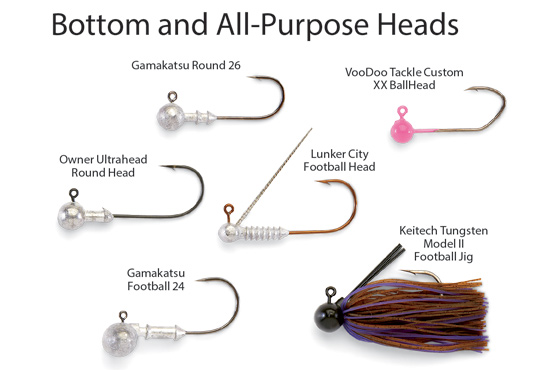
Photo by in-fisherman.com
スカートは動きを加えるだけでなく、ボリュームを追加します。モンスールは、スモールマウスを3メートル以上も浮かせて食わすために、それに期待しています。スモールマウスは目が良いことで有名なため、他の状況でも視認性は非常に重要です。私は同様のテクニックでウィードベッドやウッドカバーを通す時に、ターミネーター・フィネスジグやBooyah Baby Boo Jigs(ブーヤー・ベビーブージグ)を使用します。プレミアムフック付きのラバージグにシングルテールグラブを付けることでフォールスピードは遅くなり、より長く見せることができます。 スモールマウスはそれらをより速く見つけます。しかし、先端に垂直にアイが付いていないと、ジグは効果的ではありません。ヘッドの前方に水平にアイがあると、ヘッドがカバーにつかまってしまいます。
モンスールは夏の間、表層付近でジグをスイミングさせますが、春と秋にはディープで使います。 「スモールマウス、ラージマウス、スポッテッドバスに対し、ステディリトリーブで使います。時々はキャストしてずーっとフォールさせることもありますが、通常は水面から1メートル以内にそれを保ちます。私はそれを見ながらやるのが好きなのです。もし私が早くリールを巻き始めたらそれは、「蝶のように舞い、蜂のように刺す」をやっている時です。
ウッドカバー、アシ、水生植物などでワームを泳がせるときは、Fin-tech Title Shot Jig(フィンテック・タイトルショットジグ)、Charlie BrewerのSlider Company Spider Head(スライダーワームのスライダーヘッド)、Northland Jungle Jig-Loc(ノースランド・ジャングルジグロック)などのテキサススタイルのジグに10ポンドのラインを使用します。すべてのものがアイがまっすぐ前についているので、ストレートリトリーブでカバーをすり抜けさせるのに最適です。スライダーヘッドはオフセットフックになっていますし、他の2つは、ワームをらせんに押し込んだりするワームキーパーがあり、フィンテックジグにはワームスパイクと呼ばれるものでウィードレス効果をあげ、針先を守っています。厄介なカバーであっても根がかる直前でリトリーブを始めることでジグをスピナーベイトのように扱うことができます。
「ほとんどのワームに対し、私は約90%はタイトルショットを使用しています。」とザレスキー氏は言います。 「これは私にとって事実上のテキサス・リグとして扱っています。 フィンテックはさまざまなスタイルを取り入れていますが、私はスタンダードな流線型のジグの3/16〜3/8オンスのサイズを使用しています。
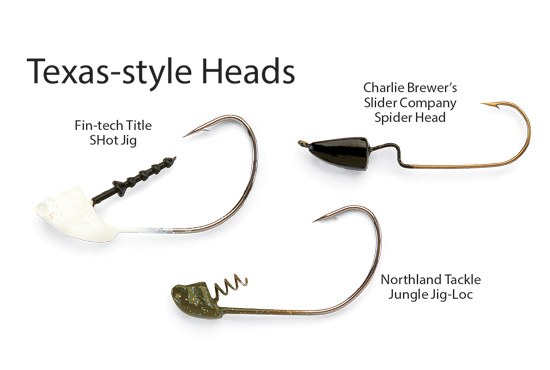
Photo by in-fisherman.com
専用ヘッド
Jeremy Altman, owner of Buckeye Lures, has made significant developments in jigs designed for specific purposes. “I’d say the Spot Remover, the Flick-It, and the Goby Sled have been the most important in terms of sales and customer response,” Altman says. “The Spot Remover is a jigworm head, designed to stand and keep a finesse worm pointing up at the fish. It may have been designed for spotted bass, but it’s become a mainstay for smallmouths and largemouths, too.”
Many jigs have been designed for wacky rigging, with smaller hooks and weedguards for finessing through cover, like the Keitech Tungsten Fine Guard Jig, which has a head that excels for “swim shaking” around cover in clear water. The Buckeye Flick-It was designed for wacky rigging on bottom. “We built it once we saw the success of Jackall’s Flick Shake Worm,” Altman says. “It’s designed for wacky presentations on bottom. The head is designed to get on bottom quickly, walk efficiently, and keep the bait in an upright position with a hook angle of about 60 degrees.”
The newest Buckeye jig is the Goby Sled, designed by inventive bass pro Anthony Gagliardi. “It’s designed to lie on bottom, with the hook pointing up,” Gagliardi says. “Lift the rod tip and it glides along bottom. On the Great Lakes, I wanted to drag a goby lure on bottom because that’s what gobies do—glide along the bottom. I couldn’t find a suitable jig to make it look natural, so I took a hammer to a 1/4-ounce sinker and pounded it flat and epoxied a hook to it. That was my prototype.
“We came up with the screw eye to secure a goby to the head later. It scoots across rock like a miniature sled. It’s made for casting—not vertical jigging. Any situation where you would cast a tube, you can cast the Buckeye Goby Sled. When a fish bites down on it, the shape of that head keeps the hook pointing up for a better hook-set. It never turns sideways like some jigs do.”
Gagliardi fishes goby baits like he fishes tubes, with a slow swim. “I use 8- to 10-pound line in clear water for smallmouths, heavier line with casting gear in cloudy water, with a 7-foot worm rod,” he says. “I use hand-pours because the flat bottom seats nicely on that head.
Buckeye Lures(バックアイルアー)のオーナーであるJeremy Altmanは、特定の目的のために設計されたジグの開発を行っています。 「Spot Remover、Flick-It、Goby Sledがセールスや顧客対応の点で最も重要だと私は思います。ザ・スポット・リムーバーは、立つように設計されたジグヘッドで、フィネスワームが魚に向かって立つように設計されています。スポッッテッドバス用に設計されているようですが、スモールマウスやラージマウスにとっての大黒柱になりました。」
ケイテック・タングステンファインガードジグのように、クリアウォーターのカバーの周りを “泳がす"のに優れたヘッドに小さなフックやウィードガードの付いたワッキーリグ用に設計されたジグも多数あります。 Buckeye Flick-It(バックアイ・フリックイット)は、ボトムでのワッキーリグ用に設計されています。 「ジャッカルのフリックシェイクの成功を見て、これを思いつきました。 これは、ボトムでのワッキープレゼンテーションのために設計されています。ヘッドは素早くボトムに着き、効率的なアクションをし、約60度のフック角度でワームがまっすぐになるように設計されています。」
最新のBuckeyeジグは、独創的なバスプロのアンソニー・ガグリアルディによってデザインされたGoby Sled(ゴビィスレッド)です。 「フックを上に向けて、ボトムに横たわるように設計されています」と、ガグリアルディは言います。「ロッドティップを持ち上げると、ボトムを滑ります。五大湖では、ボトム周辺でゴビィが滑るように動いているので、ゴビィ的なルアーをボトムで使いたかったのです。それが自然に見えるようなジグを見つけることができませんでしたので、私は1/4オンスのシンカーをハンマーで叩き、平らにし、それにフックを付けました。それが私のプロトタイプでした。」
「私たちはその後、ゴビーをヘッドに固定するためのスクリューアイを思いつきました。それは「そり」のように、岩の上を行き来します。これはキャスティング用に作られたもので、バーチカル用ジグではありません。チューブワームを投げるような状況であればどんなときでも、Buckeye Goby Sledを投げることができます。魚がバイトした時、そのヘッド形状によりフックが上を向き、より良いフッキングができます。他のジグのように横に曲がってしまうことはありません。
ガグリアルディは、ゆっくりと泳いで、チューブワームを使うようにゴビィワームで釣っています。 「私はスモールマウスの場合は8〜10ポンドのラインを使用し、濁り気味の場合はベイトタックルを使用し、7フィートのワームロッドにヘビーラインを使用します。 「ハンドポワードのワームのフラット面がヘッド形状とよく合うので、それを使っています。」
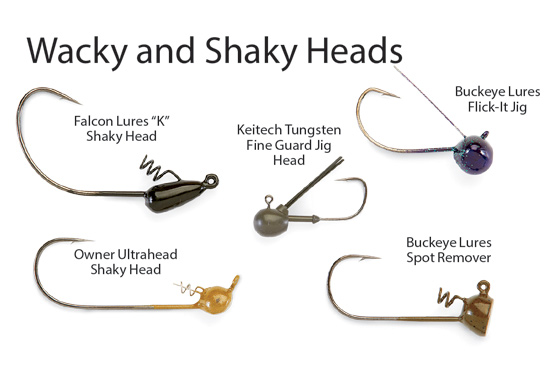
Photo by in-fisherman.com
A specialized jig arises as a solution to something that didn’t previously exist. Falcon Lures’ “K” Shaky Head is a prime example—a Texas-rig jig designed for shaky-worm tactics in dense weedcover. The growth of soft swimbaits demanded specialized heads for exposed-hook, horizontal techniques with dense plastics. Soft swimbaits tend to be heavy, demanding stout tackle and stout hooks. The Yamamoto Swim Jig, Buckeye J-Will Swimbait Head, and Lunker City Fin-S Head match swimbait tactics for big smallmouths. They’re not too heavy, but certainly heavy enough.
“J-Will Swimbait Heads have become my standard for larger swimbaits,” Zaleski reports. “I like the stout hook they use in heads that weigh only 1/4- and 3/8-ounce. The location of the line tie is great, too, making it effective around thin vegetation.”
Thin 4- to 5-inch swimbaits match 1/8- to 3/8-ounce ballheads, like the Gamakatsu Round 26 and Owner Ultrahead Round Heads, which are positive hookers, or Gopher’s Mushroom Head Jig with a VMC Barbarian hook. Another jig that dances the light-swimbait fandango well is Bait Rigs’ Pro Slo-Poke LS. Its bullet-shaped fish head is designed to stand on bottom at a low angle, keeping the hook and bait upright, like the real thing trying to hide. Its Mustad Accu-Point hook is thin, strong, and the points never bend. It balances with a wide array of tackle choices.
If a style of softbait ever needed a specialty head, it’s Berkley Gulp! It’s a great fish-catching concoction, but so slippery it tends to slide down and bunch on the hook after a swing-and-miss. Berkley designed new Gulp! Heads to solve that well enough to win the Best Terminal Tackle Award at the 2013 ICAST show. The Gulp! Grip Baitholder is the key, gripping the slippery stuff better than ever. Gulp! Heads, made with a new lead-free Tundra Composite, are available in three styles: JiggHead, Minnow JiggHead, and BDS (Bait Delivery System). The hooks are right for smallmouths—the 1/8-ounce versions with thin-wire, 1/0 and 2/0 needlepoints, and sizes up to 3/8- and 5/8-ounce for exploring deep.
The moral of my mixed-up nursery rhyme was to pay attention to drop speed and balance. No matter what smallmouth bass jigs we select (dozens of great options exist), we need to cover weights from 1/32- to 1/2-ounce. Each weight-class requires models with different hooks in different diameters to both alter drop speed and match different line diameters. Only then can your selection be “just right” for each situation.
特殊なジグは、それまで存在しなかったものに対する解決策として生まれます。 Falcon Luresの “K" シェイキーヘッドは、テキサスリグ的なジグとして、密集したウィードの中で、シェイキーワームの戦術のために設計された最たる例です。ソフトスイムベイトの成長は、ワーム素材を用いてオープンフックで使い水平に泳ぐ特殊なジグヘッドの登場を要求しました。ソフトスイムベイトは重くなりがちで、頑丈なタックルと頑丈なフックを要求します。ゲーリーヤマモトスイミングジグ、Buckeye J-Will Swimbait Head、Lunker City Fin-S Headはビッグスモールマウスのためのスイムベイト戦術にマッチしています。これらは強すぎず、しかし確実な強さを持っています。
「J-Will Swimbait Headsはより大きなスイムベイトのための私の標準となっています」とザレスキー氏は報告しています。 「私は1/4から3/8オンスの重さのヘッドで使う頑丈なフックが好きです。ラインアイの位置も素晴らしいので、薄いウィード周りで効果的です。」
細身の4〜5インチのスイムベイトは、がまかつラウンド26とオーナーのウルトラヘッドラウンドヘッド、Gopherのマッシュルームヘッドジグ(VMCバーバリアンフック付き)などの1/8〜3/8オンスのラウンドヘッドにマッチします。軽めのスイムベイトがファンダンゴをうまく踊るもう一つのジグは、Bait RigsのPro Slo-Poke LSです。その弾丸の形をしたフィッシュヘッドは、低重心によりボトムで低い角度で立ち、フックとボディは上を向き、隠れようとしているベイトフィッシュに見えるように設計されています。そのMustad Accu-Pointフックは細くて強く、フックポイントは決して曲がりません。タックルの選択肢の幅が広がります。
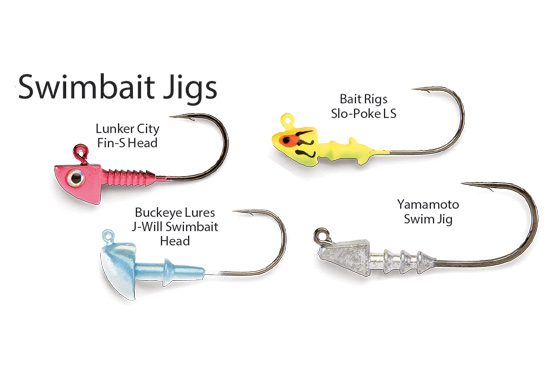
Photo by in-fisherman.com
ソフトベイトのスタイルが専用ヘッドを必要とするなら、それはBerkley Gulpもそうです。それは魚をキャッチする素晴らしい調合ですが、とても滑りやすいので、フッキングミスをするとフックから滑り落ちることがあります。バークレーは新しいGulpをデザインしました。 2013 ICASTショーで最優秀ターミナルタックル賞を受賞したもので、それを十分に解決するためのジグヘッドです。ガルプ!グリップのベイトホルダーは、これまで以上に滑りやすいものをつかむ鍵です。ガルプヘッドは鉛ではないタングステンコンポジットで作られたヘッドで、ジグヘッド、ミノージグヘッド、BDS(ベイトデリバリーシステム)という3つのスタイルがあります。フックは、スモールマウス用としては1/8オンスの場合は細いワイヤーのバージョンで1/0と2/0のニードルポイント、ディープ用に3/8と5/8オンスのサイズが使用可能です。
私が昔から教えられていたことは、フォールスピードとバランスに注意を払うということでした。私たちが選んだスモールマウスバスのジグ(何十もの素晴らしいオプションがあります)に関係なく、1/32〜1/2オンスの重量をカバーする必要があります。各ウエイトは、異なる太さの異なるフックを必要とし、フォールスピードを変更し、異なるライン径をうまく一致させる。それで初めて、あなたの選択はそれぞれの状況に対して「ちょうど良い」ということができます。
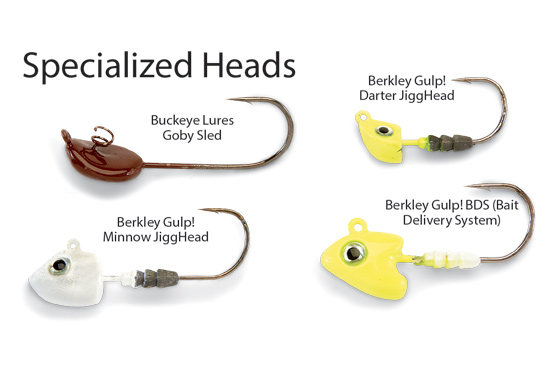
Photo by in-fisherman.com
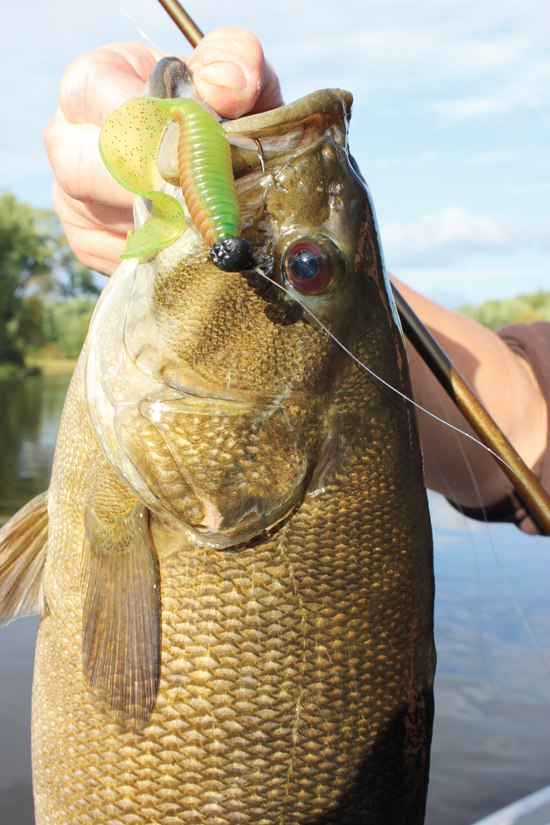
Photo by in-fisherman.com
いかがでしたか。
非常に長い文章だったので読むのに疲れてしまったと思います。すみません。
しかしこうしてみると、ジグヘッドにも色々な種類があることと、それぞれに違った役割があることに気付かされます。
もちろん、使い方も違うんですね。
野尻湖の場合、フラットエリアでのジグヘッドやフットボールジグをする場合は、根掛かりが少ないため、ジグヘッドはガードなしのラウンドヘッド、フットボールもガードなしでズル引いたりリフト&フォールで使います。
岩場のバンクで使うにしても、フックが引っ掛かるというよりは実はヘッドが岩の間に挟まって根掛かりするのがほとんどですので、ガード付きは私はあまり使いません。
しかし木崎湖の場合は、濃くはないもののウィードがありますので、ガード1本のものを使っています。ウィードガードが1本あるだけで、すり抜けといいますか、ウィードを引っかけてきてしまわない効果がすごく上がりますので、とても便利です。さすが、専用設計されたものだと思います。
こんなのはものすごい初歩的なもので、他のあらゆるジグヘッドにもそれぞれの役目といいますか、得意なことがありますが、フックのパッケージやそのメーカーのホームページなどに詳しく書いてあると思うので、自分の使いたいワーム、使いたい場所などから、自分に合ったものをチョイスすればいいと思います。
もうひとつ重要なことがありまして、ワームをジグに付けて使うと、ワームがすぐボロボロに裂けてしまうことがあると思います。これはワームを挿したからではなくて、抜けかかったり挿し直したりするために裂けてしまうことがほとんどです。
ですので、まず最初にワームをセットする際に瞬間接着剤を塗ることをおすすめします。ジグヘッドのワームを挿しこむ終点あたりとその周辺のフックシャンクにゼリー状瞬間接着剤を塗るだけで、耐久性が格段にアップします。
根掛かりを外しても、バスがミスバイトしてもワームがずれません。特にスイムベイト系のワームを付けている時はワームがずれやすいと思いますので、そういう場合にぜひ使ってみてください。家であらかじめセットしてしまっても問題ありません。
ちょっとしたことかもしれませんが、ワームのちょっとしたズレを本当にすぐに見抜いてしまうスモールには効果は抜群ですよ。
ジグヘッドリグ、スモールによく効きますので、もっと極めていきたいですね。
それでは、また。
毎度ありがとうございます!







